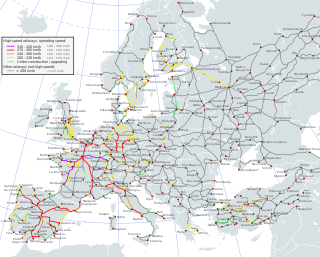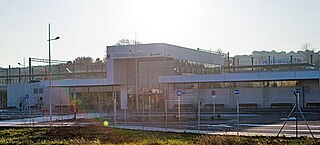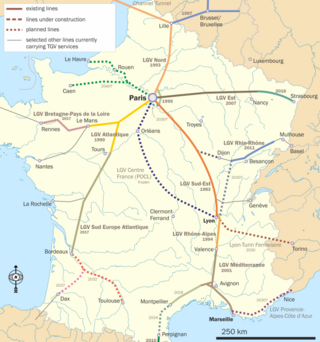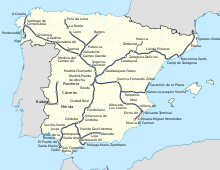
Rail transport in Spain operates on four rail gauges and services are operated by a variety of private and public operators. Total railway length in 2020 was 15,489 km. The Spanish high-speed rail network is the longest HSR network in Europe with 3,966 km and the second longest in the world, after China's.

Alta Velocidad Española (AVE) is a high-speed rail service operated by Renfe, the Spanish State railway company.

The Ligne à Grande Vitesse Nord, typically shortened to LGV Nord, is a French 333-kilometre (207-mile)-long high-speed rail line, opened in 1993, that connects Paris to the Belgian border and the Channel Tunnel via Lille.

High-speed railways in Spain have been in operation since 1992 when the first line was opened connecting the cities of Madrid, Córdoba and Seville. Unlike the rest of the Iberian broad gauge network, the Spanish High-speed network mainly uses standard gauge. This permits direct connections to outside Spain through the link to the French network at the Perthus Tunnel. High-speed trains run on a network of high-speed rail track owned and managed by ADIF, where the dominant service is AVE while other high speed services such as Avant, Alvia, Avlo, Euromed, Ouigo España and Iryo, as well as mid-speed (Altaria) services also operate.

Rail transport in France is marked by a clear predominance of passenger traffic, driven in particular by high-speed rail. The SNCF, the national state-owned railway company, operates most of the passenger and freight services on the national network managed by its subsidiary SNCF Réseau. France currently operates the second-largest European railway network, with a total of 29,901 kilometres of railway.

Barcelona Sants is the main railway station in Barcelona, owned by Adif, the railway infrastructure agency of Spain. It has become the most important transport hub of the city - being the centre of Rodalies de Catalunya including Barcelona suburban railway services and regional services, as well as the main inter-city station for national and international destinations. The station is named after Sants, the neighbourhood of Barcelona in which it is located. New parts of the station have recently been remodeled to accommodate the Spanish high-speed train AVE in the city, which started serving the city on 20 February 2008. There is also an adjacent international bus station bearing the same name, and a link to the Sants Estació metro station that serves the railway station.

High-speed rail (HSR) has developed in Europe as an increasingly popular and efficient means of transport. The first high-speed rail lines on the continent, built in the 1970s, 1980s, and 1990s, improved travel times on intra-national corridors.

The Madrid–Barcelona high-speed rail line is a 621-kilometre (385.9 mi) standard gauge railway line inaugurated on 20 February 2008. Designed for speeds of 350 km/h (217.5 mph) and compatibility with neighbouring countries' rail systems, it connects the cities of Madrid and Barcelona in 2 hours 30 minutes. In Barcelona the line is connected with the Perpignan–Barcelona high-speed rail line leading into France which connects it to the European high speed network.

The history of rail transport in Spain begins in the 19th century. In 1848, a railway line between Barcelona and Mataró was inaugurated, although a line in Cuba connecting Havana and Bejucal had already opened in 1837. In 1852 the first narrow gauge line was built, in 1863 a line reached the Portuguese border. By 1864 the Madrid-Irun line had been opened, and the French border reached.
The Perthus Tunnel is a twin-bore railway tunnel between France and Spain under the Eastern Pyrenees, built as part of the high-speed railway line Perpignan-Figueres. It has made possible the implementation of direct high-speed trains connecting the two countries' railway systems since December 2013, linking the Spanish AVE network with the French TGV. The tunnel is named after the nearby border town of Le Perthus.

The Renfe Class 100 is a high-speed train used for AVE services by the Renfe Operadora, in Spain. It was the first high-speed train put into service in Spain, in 1992.

Avignon TGV is a railway station located in Avignon, France. It was opened on 10 June 2001 and is located on the LGV Méditerranée high-speed line and Avignon-Centre–Avignon TGV railway. The train services are operated by the SNCF. The station is located 6 km south of the city centre.

France has a large network of high-speed rail lines. As of June 2021, the French high-speed rail network comprises 2,800 km (1,740 mi) of tracks, making it one of the largest in Europe and the world. As of early 2023, new lines are being constructed or planned. The first French high-speed railway, the LGV Sud-Est, linking the suburbs of Paris and Lyon, opened in 1981 and was at that time the only high-speed rail line in Europe.

Perpignan station is the railway station serving the city of Perpignan, Pyrénées-Orientales department, Occitanie, southern France. Part of the station was decorated in the style of Salvador Dalí, for whom the place held special significance, having proclaimed it to be the "Centre of the Universe" after experiencing a vision of cosmogonic ecstasy there in 1963 and made a painting called La Gare de Perpignan in 1965.

Figueres–Vilafant is a railway station serving the city of Figueres in Catalonia, Spain. It is located in the municipality of Vilafant, at about 2 kilometres (1.2 mi) west from its urban center and 1.5 kilometres (0.93 mi) from Figueres city centre. The station is on the Perpignan–Barcelona high-speed rail line and is served by Renfe Operadora's AVE and SNCF's TGV high-speed trains.

The Contournement Nîmes – Montpellier, also known as the LGV Nîmes–Montpellier, is a French high-speed railway line, bypassing the cities of Nîmes and Montpellier in Southern France. It has the distinction of being the first ligne à grande vitesse to be intentionally built for mixed passenger and freight traffic.

The Portet-Saint-Simon - Puigcerdà railway is a secondary railway line in southwestern France. It connects Portet-sur-Garonne, 11 km south of Toulouse on the Toulouse–Bayonne railway, to Latour-de-Carol and Puigcerdà, towns located on each side of the French/Spanish border in Cerdanya. The railway was opened in several stages between 1861 and 1929.

Avelia Euroduplex, more commonly known simply as Euroduplex or TGV 2N2 in France, is a high-speed double-decker train manufactured by Alstom. It is primarily operated by the French national railway company SNCF, and also in operation with the Moroccan national railway company ONCF. It is the 3rd generation of the TGV Duplex.

The Barcelona–Cerbère railway is a 168-kilometre (104.39 mi) railway line linking Barcelona in Catalonia, Spain to Cerbère in France. It is served by the Rodalies de Catalunya commuter network, Renfe regional, MD, AVE, Avlo and Avant train services, and TGV trains. The line stars at Barcelona Sants railway station, and passes through the Catalan regional cities of Girona and Figueres before reaching the French border, and then Cerbère, just across the border. It is an important commuter and High Speed line, connecting Paris, Montpellier and Perpinyà to Spain.

The LGV Montpellier–Perpignan is a proposed high-speed rail line between the French cities of Montpellier and Perpignan, at which points it will link with respectively the Contournement Nîmes – Montpellier and the LGV Perpignan–Figueres. The project includes two new stations in Béziers and Narbonne. Montpellier–Béziers and Rivesaltes–Toulouges will be for mixed traffic, with Béziers–Toulouges being for passenger traffic only.
























